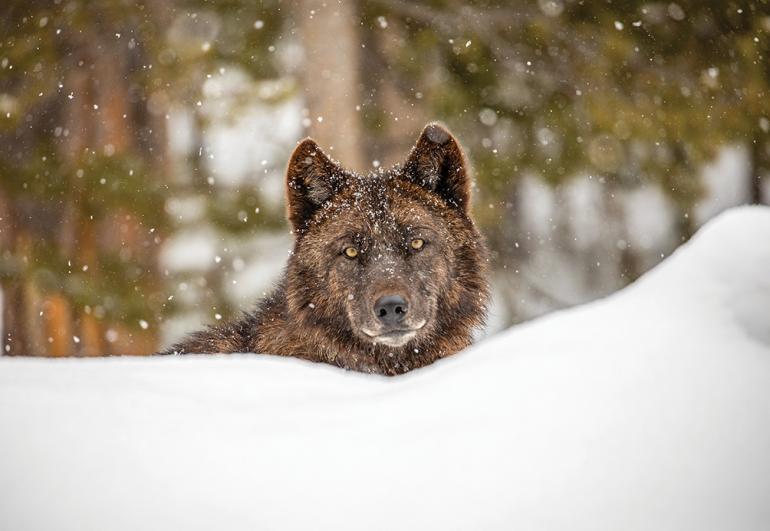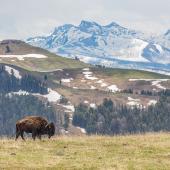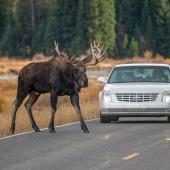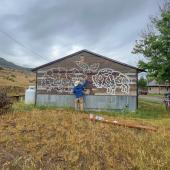Pack Mentality
Following Yellowstone's wolves.
Fall’s pre-dawn chill saturates the frosty stillness of Yellowstone Park’s northeast corner. Lizzie Cato, petite, freckled, and bundled in many layers and textures of purple, leaps into the driver’s seat of her government-issued Dodge Durango. Her gloved hand fumbles with the settings of a telemetry receiver—a walkie-talkie-shaped device that translates radio waves from tagged wildlife into a series of high-pitched, staccato beeps. This particular receiver is programmed to scan the frequencies emitted from the collars of Yellowstone’s wolves. Attached by a cable to an omnidirectional antenna secured to the Durango’s roof, the receiver, if unencumbered by terrain, can detect the presence of wolves several miles away. When not receiving a signal, the device emanates a steady stream of soft, sputtering static. This static fills the vehicle as Lizzie fishes in the pocket of her down jacket and produces a small digital recorder. “September 28th,” she says into the mic, the break in her voice betraying the earliness of the morning, “6:33am, 32 degrees Fahrenheit. Begin monitoring.”
As we slip away from the sleepy residential area of Tower Junction, Lizzie explains what we’re looking for: the Junction Butte wolf pack. Reports indicate that hunters may have over-harvested from the pack, taking more wolves than their permits allowed. A relatively large and visible pack, the Junction Butte wolves are well known to Yellowstone’s spotting-scope-toting cohort of devoted wolf-watchers—endearingly nicknamed “wolfies”—who brave summer crowds and winter storms to catch glimpses of grizzled fur. Many wolfies have observed generations of wild canine life and death, and they view hunting with contentious aversion. Lizzie wants to find out if their accusation of a missing wolf is true.
As a technician with the Yellowstone Wolf Project, Lizzie’s primary focus is to observe and record wolf behavior. She usually drives into each morning’s pre-dawn light with a question or two to pursue. Today, in addition to investigating the Junction Butte pack, she may attempt to find the black wolf recently spotted with the Lamar Canyon pack that not even the wolfies could identify. Or she may track down the Mollie’s pack, which signals suggest, is on the move from its Pelican Valley stronghold toward elk herds in the northern range, where there is high risk of clashing with territorial resident packs. By meticulously documenting these daily sagas, Lizzie is able to contribute to a comprehensive dataset that is highly unique, in that it is based primarily on visual observation. The Wolf Project directly incorporates this data into management practices and academic research.
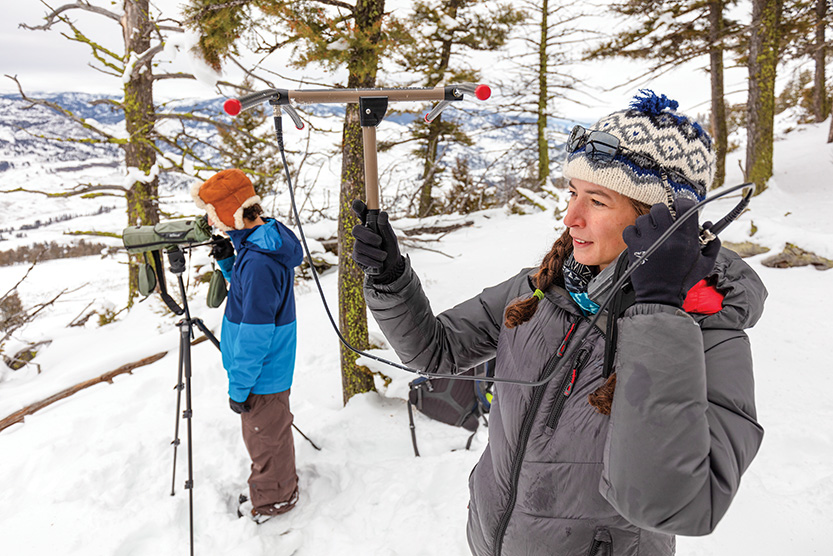
Using telemetry to locate a pack.
Pronghorn antelope spring mirage-like through boulder-strewn sage flats as we wind our way through the heart of the Junction Butte pack’s territory. A dawn breeze runs its fingers through the feathers of a quiet raven. Attentive atop its rocky perch, it too, perhaps, awaits some sign of the wolf. The receiver hums static. Willing some signal to permeate the monotonous din, Lizzie pulls over near the pack’s den site at Slough Creek. The den itself is abandoned until next spring, but the Junction Butte wolves still frequently travel the cliff bands high above the confluence, or nap between patches of forest near the river’s edge. The Durango now quiet, the receiver’s crackles are more distinct, its drone more dynamic. Lizzie jumps as a thin, weak signal barely permeates the static. “A Junction Butte female!” she announces, hastily gathering the materials she needs to try to pin down the signal’s origin. She steps out of the vehicle and into the brassy dawn, holding the receiver close to her ear and a directional antenna above her head, slowly turning 360 degrees, listening. “Nothing,” she sighs after a few minutes, slumping slightly, bringing the antenna to her side. She offers the apparatus to me. “Wanna give it a go?” Though not particularly confident that my efforts will yield better results, I accept the receiver and begin the familiar ritual of turning and listening.
Following the reintroduction of wolves to Yellowstone National Park in 1995, the Yellowstone Wolf Project initiated an intensive Winter Study program designed to monitor wolf predation patterns in an ecosystem long deprived of its top predator. A few winters ago, Lizzie and I were fellow interns on this project, assigned to radio-track and observe the Lamar Canyon pack, which consisted of the alpha pair and their six gangly, rambunctious, nearly-grown pups. The pups’ clumsy curiosity provided comic relief from the turbid uncertainty that often defined the pack’s daily survival. Through the thickening and thawing of winter, we witnessed the alpha female succeed in killing a bull elk by cornering him at the precipice of a basalt cliff; we cringed as patches of mange crept forebodingly up the alpha male’s legs; giggled as the pups rolled down snowbanks like frisky otters; and, in March, we observed with anticipation as the alpha female’s sides swelled with a new brood. Not long afterwards, the most dramatic of the winter’s episodes unfolded.
One mid-morning in March, brazen sunshine reflected from the gold-flecked fur of the Lamar Canyon pack’s alpha female as she led her pack northeast. Having consumed all but the bones of a recently killed cow elk, the pack crusaded energetically toward Slough Creek, where the remains of a winter-kill bison lay warmly decaying. The Lamar wolves had scrupulously scavenged the bison’s frozen sinews for weeks, but in their recent absence, the Prospect Peak Pack—fourteen robust, adult wolves—had discovered the carcass, and now lolled with full bellies in the patchy snow. When the unwitting Lamar wolves appeared on the horizon, the Prospect Peak pack rose, rapt with poised focus. They charged in a synchronized, explosive attack. The Lamar alpha female instantly bolted, protecting herself and her unborn young. Her pups scattered, frantic. The alpha male, however, braced himself and bore the full brunt of the attack as the Prospect wolves rammed him like a flood. They surged over and around him, grabbing, pulling, and ripping fur and flesh. After several tense seconds, the Prospect wolves released him to pursue the howling pups. Bedraggled beyond recognition, coat stained with saliva and blood, the Lamar alpha male limped down a gravel riverbank and disappeared into the sage.
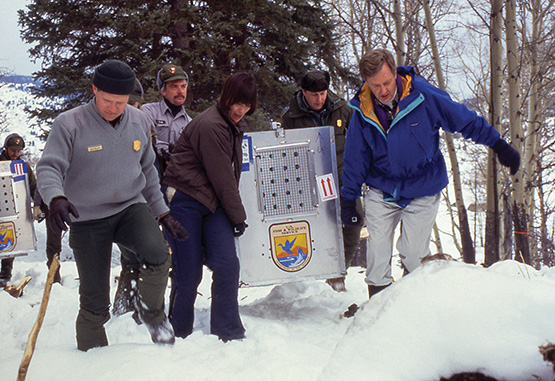
The first wolves return to Yellowstone, 1995.
I stare at the same riverbank now. It bears no sign of battle, beyond a lively row between a pair of chickadees in a leafless willow. As I hold the telemetry antenna above my head, turning and listening, I recall the weight of loss I felt following the Lamar wolf’s death. For two days after the battle, his signal pulsed from the sage like a heartbeat. But then the signal became a single note, droning into infinity like a flatline on a heart monitor. He was dead.
I wished the Wolf Project biologists had done something. I wished they had marched into the sage with tranquilizers and a gurney and hauled the battered wolf to medical care. His mate would deliver pups in just a few weeks, and it seemed that the lack of human intervention was a death sentence not only for the alpha male, but for the future of his entire pack.
But I also knew that humans had done enough meddling already. It was humans who drove gray wolves to extinction in the majority of their native range in the 1920s, and humans who staged the complex and highly successful wolf reintroduction. And of course, humans now dictate the number of wolves that may be legally killed by hunters each fall. Management practices seem constantly on the verge of demeaning wolves to pawns in a great game of Wilderness played by head-butting teams of government agencies, scientists, and special-interest groups advocating everything from wolf glorification to wolf annihilation.
The telemetry receiver in my hand is one manifestation of that game. But its purpose is to enable observation, not intervention. And even when it allows us to witness painful moments of wolf wildness, the least we can do is to allow them to unfold, unencumbered by human touch.
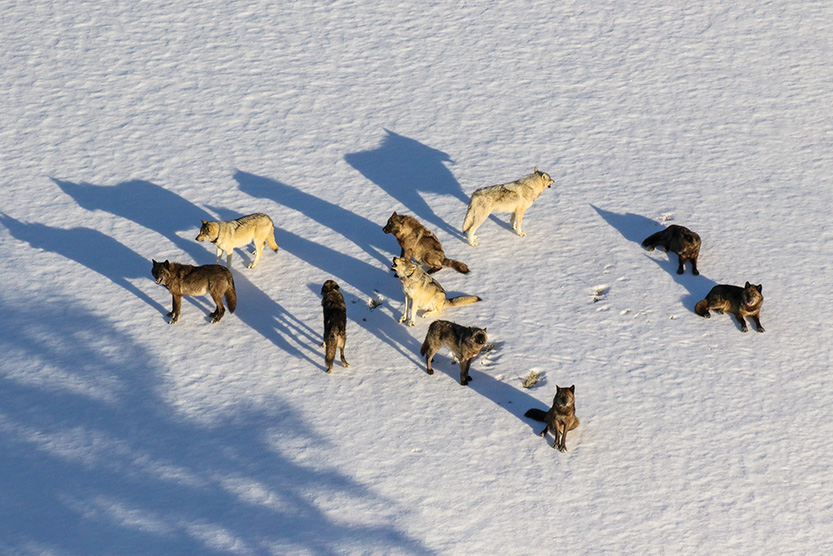
The Junction Butte pack.
When no signal emerges from Slough Creek, Lizzie and I head back in the direction we came from, hoping the wolves have shifted in a way that offers a stronger signal. As we drive, dawn’s arms reach into the valley, emboldening stands of fiery aspens. A red fox picks its way through the roadside sagebrush. It sits on its haunches as we approach, black ear tips thinly visible through silver branches. The canines we seek, however, remain absent.
At 7:30am, a gruff voice crackles through Lizzie’s radio. “I’ve got four wolves on the move from Crystal Creek. Two grays and two blacks.” It’s a wolfie. Lizzie beams as she keys the radio to respond, “What direction are they heading?” “Toward Fossil Creek.” Lizzie pulls a U-turn.
The number and color configuration of wolves described does not match the Junction Butte pack, nor does it match the Lamar Canyon pack, with or without their mysterious visitor. However, it does align with a subgroup of the Prospect Peak pack; a troop of bachelor males that has departed from their primary pack, likely seeking higher social rank. Despite the fact that these particular wolves aren’t Lizzie’s top priority today, they are near enough to attempt catching a glimpse.
The shoulder adjacent to Fossil Creek is already lined with vehicles, spotting scopes, and cameras mounted on tripods when we arrive. Some wolf-watchers mingle casually, while others squint fixedly into their scopes. Lizzie and I unload optics and begin to scan the undulating tawny landscape. “Oh… I got ‘em!” Lizzie’s voice wavers with excitement. I pan my scope to a lodgepole-topped knoll, and am startled as two black wolves trot nonchalantly through my field of view. I peer closer: they’re flanked by a pair of gray wolves, camouflaged by sagebrush and mottled shadows. Lizzie swaps her scope for the telemetry equipment, and confirms that one of the black wolves is 996, a male of the Prospect Peak sub-group.
The four wolves weave lithely through the sage, appearing coolly indifferent to one another yet simultaneously of one mind, like a flock of waxwings coordinated in flight. Their ears are perked forward, mouths slightly agape, tails relaxed—collectively intent on their destination, unspoken but understood.
As I observe the group’s fluid procession, it’s difficult to imagine them as the wolves that killed the Lamar Canyon alpha. I had unintentionally maintained a single, bloody image of the attack as my sole reference point for this pack. But of course, that morning in March had been just another day in the life of Yellowstone wolves. And ultimately, it was not the death of the alpha male that would trigger the downfall of the Lamar wolves. Rather, it was a hunter who would legally shoot and kill the alpha female of the Lamar Canyon pack. Sandwiched between the Park boundary and rival wolves’ territory, the Lamar pack navigated many dangers. But of them all, humans proved the most detrimental.
The four Prospect Peak males settle to nap on the cool earth beneath a lodgepole pine, panting in their thickening fall coats. The flicking of their ears, the spreading of toes as they stretch stiff legs and relax their heads to the ground, is all so reminiscent of my days spent with eyes fixed on the Lamar wolves.
Lizzie begins packing up her spotting scope. We pile into the Durango and weave through the valley back toward Tower Junction. Lizzie catches word that the Mollie’s pack might be visible west of here, on the Blacktail Plateau. The telemetry receiver drones a familiar static. Each frequency represents a different wolf, subsisting somewhere among sagebrush and pine, defending itself and its pack, and spreading its toes as it drifts into sleep.


